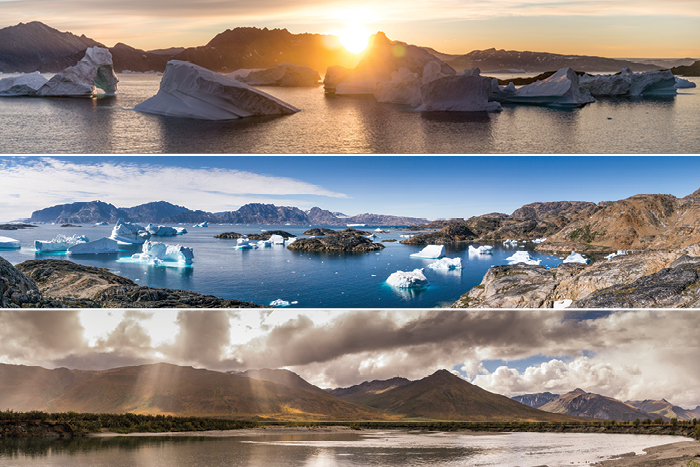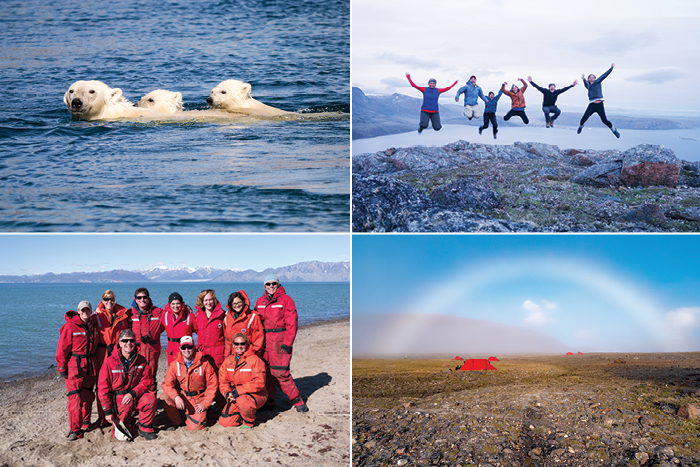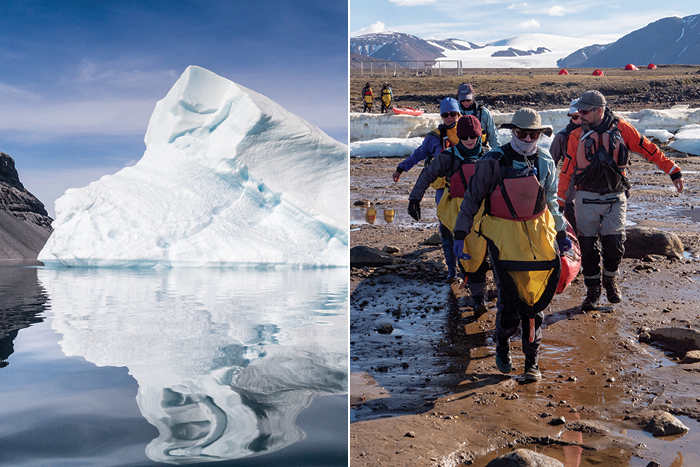Call of the Wild

Professor of Earth Sciences Ben Edwards and John Pohl ’78, P’06 have been capturing the rugged and unspoiled Arctic in photographs in hopes of sharing its jaw-dropping natural majesty—and a message of the need to conserve it—with a larger audience. The two are cataloging the photographs they’ve taken, and some are featured in a permanent photo display in the Waidner-Spahr Library. Photographs of Arctic regions and of the trips are also posted at geophotography.org. A few are reproduced here.
Distinctive Arctic program marks major milestone
by MaryAlice Bitts-Jackson
First, a small aircraft carries you over the Arctic, your camping gear and science equipment in tow. Then you touch down, no airport in sight. You take in exotic wildlife and snow-capped mountains as you hike or kayak to an even more remote area. You may connect with an Inuit guide who can show you a safe path across the frozen ocean.
And then the research begins. During the past seven years, Dickinson’s Arctic program has provided 35 student researchers with wild and rare fieldwork opportunities like these. This year, the program marks a significant milestone, thanks to permanent funding made possible by alumni. This funding supports an endowed faculty position and coursework and fieldwork in one of the most valuable and vulnerable ecosystems in the world.
Learning by experiencing
The program began with a 2013 student-faculty-alumni fieldwork trip to Baffin, Bylot and Aulattivik islands, Canada. Four students took that flagship trip, along with Professor of Natural Philosophy Marcus Key, John ’78, P’06 and Susan Wyckoff Pohl ’80, P’06 and the Pohls’ daughter Merryl, a science teacher.
Susan, then a Dickinson Board of Trustees member, had a vision for experiential education at her alma mater. John, a geology and political science double major, had previously been on a Dickinson student-faculty geology research excursion in Sicily and had enjoyed the experience. As they hiked, camped and collected samples alongside students in Arctic Canada, they recognized an exceptional opportunity to give back.
Seven years and 11 fieldwork trips later, and with the Pohls’ support, student-faculty teams have studied ice, lakes, volcanic rocks, glaciers and archaeological remains in Greenland, Alaska, Canada and Iceland. They’ve surveyed methane levels in freshwater lakes and used high-tech equipment to measure and map volcanic rocks and glaciers. They’ve interacted closely with local guides and learned about indigenous cultures. Some have collected additional data for their senior theses.

The students have also gained a deeper understanding of the land’s unspoiled natural resources and the pressing need to preserve them—some by rafting through the Gates of the Arctic National Park, others by kayaking through walrus-inhabited waters or by camping out on the ice, hiking to remote glaciers or soaring above the lip of a volcano by helicopter to do critical research.
After their return, they’ve analyzed findings and presented original research at national conferences and co-published scientific papers.
The mother of invention
That high-level work—along with the experience of team problem-solving on the fly in a challenging Arctic environment—sharpens skills applicable to any field. For those now pursuing environmental and science careers, it’s potentially careerdefining. Some, like Arctic program alumni Allison Curley ’19 and Will Kochtitzky ’16, are continuing to see the effects. A recent collaboration, springing from fieldwork during Curley’s junior year, is a prime example.
Realizing that the student-faculty research team would use paper maps during the 2018 Arctic trip because no internet access would be available, Curley used geographic information systems (GIS) technology—a high-tech mapping tool—to create an interactive map. That inspired Professor of Earth Sciences Ben Edwards to use the department’s new GPS unit during the 2018 trip to make high-precision measurements of glacier melt. Curley, Kochtitzky and Edwards then used GIS to record the retreat rate of eight glaciers, using satellite images and photos from 1959 to 2019. The research group is preparing a paper for journal publication this fall.

On the map
This year’s establishment of sustained program funding, spearheaded by the Pohls, ensures that still more high-level Arctic study and research is ahead, and the newly endowed Arctic program faculty position helps pave the way for expanded partnerships with the University of Ottawa, the Smithsonian Natural History Museum and others, as well as more interdisciplinary research.
It’s a chance for students to research global cultures and to speak with indigenous people about their connections to the land while exploring the Arctic, side by side, with them. That was the case during a past trip, when students studying sea ice discussed the effects of climate change with an Inuit guide who’d led them to a safe sample-collection site on the ice. As they drilled through the ice to measure its thickness, they were stunned by the guide’s ability to estimate the measurements on sight.
This is what a liberal-arts inflection on climate science looks like, and it’s an area for which Dickinson, as a leader in sustainability and global education, is poised to become nationally known.
“The Arctic is a popular location for environmental research, and you often read about the Arctic region in the news because there are a lot of countries that want to use Arctic
waterways and Arctic resources,” says Edwards, who serves as the program’s first endowed faculty chair. “So it’s very exciting that in just seven years, we’ve developed a program that places Dickinson on the forefront of undergraduate institutions that take on these issues.”
“That, in addition to getting the students up to the Arctic so they can understand the importance of protecting it, was the main reason that we wanted to do this,” says Susan Pohl. “We wanted to put Dickinson on the map for its Arctic and Alpine research.”
Read a sidebar, "So what happens to Arctic research during a pandemic?", to learn how in-person research shifted this year.
Read more from the fall 2020 issue of Dickinson Magazine.
TAKE THE NEXT STEPS
Published November 6, 2020